99% of the time, we turn to our search engines whenever we need to learn more about something or find an answer to a question. We do so because to a large extent, we trust that they not only have the answers we seek but will provide the best of all the possible answers available in their database, and that, promptly.
But have you ever stopped to ask how they do what they do and how they decide which content is the best result for a search query? Because it takes less than a minute for us to see the results of our searches, we may have assumed that not so much is done behind the scenes. However, you may marvel at all that goes on behind what you see on your screen for you to get relevant results for a simple search like “ice-cream shops near me”.
What are Search Engines?
Search engines or SEs as we’ll be using in this article are in their most basic form, answer machines. That is, they exist to provide relevant answers and useful information to users whenever they are requested. They are advanced internet-enabled computer programs that crawl the web for results that match a user’s query. Google, Yahoo, Bing, Baidu, Yandex, and YouTube, are popular SEs.
These computer programs have been around since the early 90’s when the Web debuted. Then it was only Archie, which was the first well-documented engine, although it was nowhere as competent as the ones available today.
In 1994, SEs began taking the form they have presently when Jerry Lang and David Filo created Yahoo Search. By 1998 Google was created and by the year 2000, it had taken center stage in this space, a position it has held till this day. Click here to learn more about the history of SEs.
Today, there are several others as having been mentioned earlier but Google remains king, holding more than 90% of the global search market share with Bing and Yahoo trailing behind.
How Do They Work?
To function effectively they carry out three basic steps. These steps are:
- Crawling
- Indexing
- Ranking
Crawling
Crawling is the process by which these advanced computer programs find old, new, and updated content on the web. They do so by sending out crawlers, also called spiders or bots to crawl the web, reviewing websites. These bots take note of data like code, sitemaps, and URLs to determine the type of content on the website.
Indexing
Once a website is crawled, SEs decide how best to organize and categorize the information on a website. It is through this process that they decide where the site will rank on a SERP when there’s a relevant query.
Ranking
While a site is being indexed, a SE begins to decide where specific contents on the site will rank on its SERP. This decision is based on several factors including the quality of the content and how relevant it is to a user’s query. Other factors include the user’s location, language, device, and so on.
Search Engines- Librarians for the Web
The functions of SEs are very similar to those of a librarian. A library is a place where books on various topics and disciplines are stored for use by the public and it is kept or managed by a librarian. The job of a librarian is simple.
They are to ensure the books in the library are well organized into categories. For example, there may be several books written on a particular topic, say gardening. It is the job of the librarian to ensure that all these books are kept together so that they can be easily found.
Another important aspect of their job is to help customers find the books they are looking for and recommend the most relevant ones; we’ll use the gardening example again. Say you walked into a library you’ve never been at before and you need to find a book on gardening. After making your request to the librarian, you’ll be presented with all the books associated with the word “gardening”.
Making a choice from the available options will be easy since you’ll pick the most relevant one. For example, you may pick a book titled “Gardening for Beginners” over “Farmers vs Gardeners”. Now, let’s bring all of this to context.
The library and the librarian represent the web and SE respectively, while the customer is the user and the book being sought for is the query or keyword. The shelves where the books are placed are databases or servers where indexed content is stored.
Understanding SEO
SEO is the short form for search engine optimization. It is the practice of improving the quantity and quality of website traffic and increasing brand exposure through non-paid or organic search results. Many websites struggle to rank on SEs because SEO best practices are yet to be implemented on them.
While this concept may appear daunting to many website owners, the few that have understood its fundamentals have been able to reap its many benefits. At its core, SEO is simply about understanding people, how they search for information on the web, and tailoring every bit of your website to match to the closest proximity, the keywords users use to conduct searches.
For example, if your website is all about dogs, according to SEO best practices, try as much as possible to include the word “dog” in your URL. If this is not possible, related words like pet or canine can suffice. It really is this basic.
There are other technical aspects to SEO, however, getting this part right takes care of most of the work.
These technical aspects have to do with your style of coding, hyperlinks, metatags, headers, sitemaps, robot.txt, markups, domain authority, and so on. The good thing about SEO is that you don’t have to do it yourself as there are agencies that help websites with this, and you can find them by running a simple search. For example, someone living in Detroit could simply search for Detroit SEO agency and find those around the area.
Conclusion
For a website to get the quantity and quality traffic desired without running ads, search engine optimization is a no-brainer. It not only generates more revenue, but it also makes the site much more responsive and trustworthy since most users tend to only click on the websites that appear on the first results pages.



